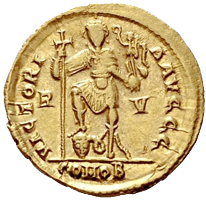
This page created 27 September 2014, and last modified: 29 July 2015 (Leg XIII commentary added)

The Dianenses is listed (21.17 in Ingo Maier's numbering scheme) as the third of the eight legiones comitatenses under the comamnd of the Magister Militum per Illyricum. Its shield pattern (20#7) as shown in various manuscripts, under the matching label (20.g) Dianenses, is as below:

The pattern shows a red outer rim, an indigo-violet main field (appearing more purple in B, mauve in W, and faded to pink in M), and a yellow boss. Surrounding the boss are three concentric white rings; these and the main field (but not the boss) are overlaid by what appears to be a serpent with a human head, like an Indian naga; the Dianenses is the only unit in the Notitia bearing such a charge. The body and face are white (except in M, which has blue); the hair is black (blue in M, white in W). An alternative explanation would be a head impaled on a pole (a common enough motif in the Notitia; see, e.g., the Invicti seniores, (98/9.57), but that would not explain the clearly sinuous "tail".
| The snake-with-a-human head interpretation is greatly reinforced by its appearance in other contemporary Roman sources. An early example appears to come from the late 3rd/early 4th-century Piazza Armerina mosaics in which one is depicted as part of a picture depicting the labours of Herakles; I have not been able to locate a copyright-free image of this, however. More public examples of such imagery come from coinage, especially that issued under Valentinian III. That shown to the right is a gold solidus dated to 426-430; i.e. the same decade during which the Notitia was last updated, and issued from Ravenna. The emperor is shown with his foot resting upon the head of human-headed serpent. |

Image taken from www.coinarchives.com |
The name Dianenses appears at first blush to refer to the goddess Diana. This is a particularly easy connection to make, given the preceding unit in the Magister Militum per Illyricum's list is the Martii (21.16), and another (21.12) is called the Minervii, and thus are both named after divinities; AHM Jones certainly thought this was the case (vol 1, p 59; vol 3, p 375). Nonetheless, in my opinion, it is a false connection; the name much more likely comes from the spectacular 1.7 ha fort at modern Karatas near Kladovo in Serbia, within the Danubian Iron Gates, and which was called Diana in Roman times. Presumably the unit was stationed there before joining the field army; in the Notitia, the fort's name is curiously absent. Many bricks stamped DIANA have been found at various other forts in the Iron Gates region (see Constantin Bajenaru (2010), Minor Fortifications in the Balkan Danubian Area from Diocletian to Justinian; available here at p 109, 113, 115); in addition, the site at Bordej (ibid, p 123) reveals stamps bearing (among other legends) CO I DIIANA, indicating a "Cohors I Diana".
The Notitia's Dianenses, being a legionary unit, presumably did not descend from Cohors I Diana, which would seem to be an auxiliary unit, since legionary cohorts, if they give their number at all on tile stamps, always seem to have given the legion number as well. The local legion at the time of the Notitia's compilation was Legio XIII gemina (80.23-27), under the Dux Daciae ripensis, and since it had been for well over a hundred years, since the days of Marcus Aurelius, it is by far the most likely candidate for the origin of any legionary detachment occupying the fort. The Tertiodecimani (18.16), under the Magister Militum per Thracias, is clearly another detachment of the legion.

Return to the Notitia alphabetical unit list page.
Return to my Notitia index page.